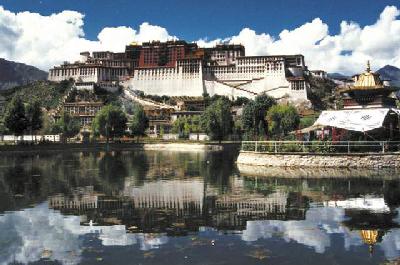Potala Palace
 Situated on Hongshan Mountain in Lhasa, the capital city of the Tibet Autonomous Region, Potala Palace is 3,700 meters above sea level.
Situated on Hongshan Mountain in Lhasa, the capital city of the Tibet Autonomous Region, Potala Palace is 3,700 meters above sea level.
In the seventh century, King Songtsan Gambo of the Tubo Dynasty had the princesses of Nepal and Tang emperor as his concubines. To mark the marriage, he built the 999-room palace, which covers an area of 410,000 square meters and has a floor space of 130,000 square meters. The palace is the quintessence of ancient Tibetan architecture and is listed as a world cultural heritage site.
The complex is divided into two sections, the Red Palace and the White Palace. The latter served as the living quarters for succeeding Dalai Lamas and was a place for them to handle political affairs. The Red Palace houses eight funerary stupas of Dalai Lamas covered in sheets of gold. The 13-story main building is 115.703 meters high. Five of the palaces have gilded bronze tiles and are considered holy palaces on highland. The palace was designed and built to take best advantage of the sunlight on the plateau and in its wide and solid foundations there are tunnels and vents. Each hall or bedroom has a skylight to allow daylight and fresh air in. The columns and beams of the palace are carved while the walls are painted with colorful murals. Since ancient times, Tibetans have painted their timber and pottery articles and the murals in the Potala Palace total some 2,500 square meters.
Tangka or Buddhist scroll paintings are usually done on cotton and some are patch work or embroideries. Tibetan ones are painted on cotton cloth. As with paintings, Tangka are based on different themes such as Buddhas and historical figures, as well as history, medicine, architecture and arts. The paintings are usually in vivid colors.
Potala Palace houses many iron, bronze, gold and silver articles, such as weapons, from the Tubo Kingdom. There are also sacrificial articles from the same period and leather, textile, paper, porcelain and carved stone goods as well as gems, seals and the golden documents issued by emperors to the Dalai Lamas.
In 1961 Potala Palace was listed a national cultural site under state protection. The palace was repaired in 1989 with funds provided by the central government. In 1994 it was included in the world heritage list by UNESCO.
Included in the UNESCO world heritage list in 1994.
Source: http://old.cnta.gov.cn